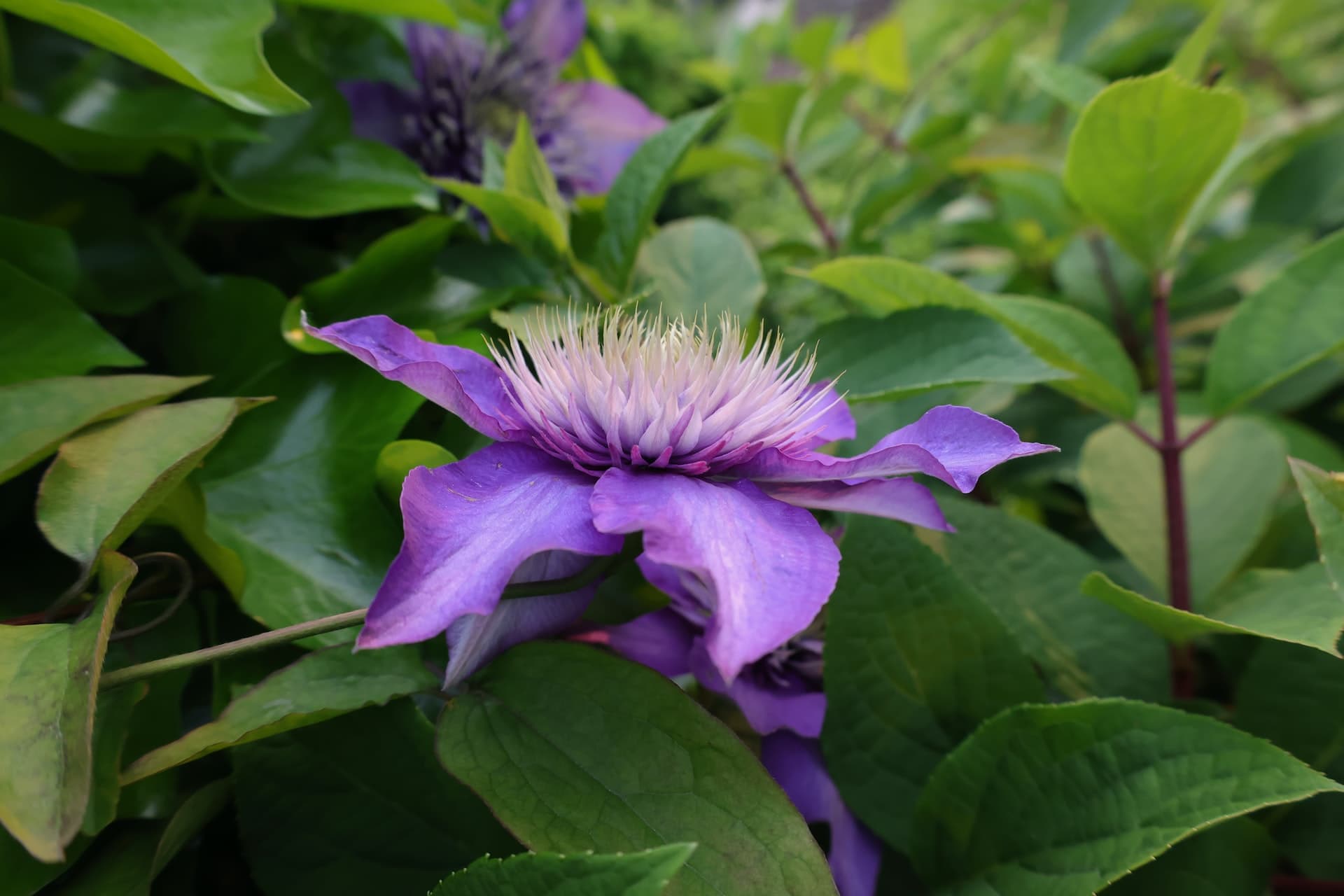Clematis can overwinter in pots relatively easily, although there are a couple of steps that you have to take if you want to be sure that your Clematis comes back in the spring. Clematis are perennial plants and they will have no problem coming back even if the winters get well below freezing.
To overwinter Clematis in pots, make sure to mulch it, this will protect the potting mix from freezing and will also stop it from drying out. You can also cover your Clematis with a plastic bottle, or a plant cover, as these will act like a greenhouse that traps in heat and moisture. Watering the Clematis during the winter is extremely important, as these plants are prone to drying out, although you should only water them if the top inch of the soil is dry.
If you want to leave your potted Clematis outside during the winter, then my personal recommendation is to use a frost and UV resistant pot Click here to check it out on Amazon.com
One of the main reasons why Clematis tend to die in pots during the winter is because they simply dry out. Way too many people simply leave the potted Clematis outside and never water them in the winter. A couple of windy days can easily dry out the potted Clematis, and once their roots have dried out they will definitely die. The main reason people tend to stop watering the Clematis in the winter is because they tend to look dead, but this is how they normally look when they are dormant.
If you want your Clematis to survive the winter in the pot, then make sure to water it once a week, but only if the top inch of the soil is dry. If you are not sure what kind of Clematis you have, then check out my recent article What Kind Of Clematis Do I Have ( 6 Ways To Identify Clematis ).
Clematis In Pots Over Winter
Overwintering clematis in pots requires some special care to ensure their survival and healthy growth. Start by choosing a suitable pot with good drainage and insulation to protect the roots from freezing temperatures. Before winter arrives, trim the clematis back to about 6 inches above the soil level to prevent wind damage and to encourage new growth in spring. Place the pot in a sheltered location, such as against a wall or under an overhang, to provide some protection from harsh weather conditions.
Insulate the pot by wrapping it with bubble wrap or hessian sack, which will help to maintain a more stable temperature for the roots. Water sparingly during winter, as the plant will be in a dormant state and will require less moisture. In extremely cold climates, consider moving the pot to an unheated garage or shed to provide additional protection. Monitor the plant throughout winter, checking for any signs of frost damage or excessive dryness. In early spring, remove the insulation and resume regular watering and feeding to support new growth.
Earn a 50% Commission on each sale by simply sharing my guides with friends and family on social media, check out Flower Duty Affiliates
Use The Right Kind Of Pot For Overwintering Clematis
Not all pots are equal when it comes to overwintering Clematis, although the size of the pot is also extremely important. Clay or terracotta pots are best for overwintering Clematis, but only if they do have drainage holes. If the clay or terracotta pots do not have drainage holes then most of the water will simply freeze in the pot. These pots can easily crack if they hold on to too much water.
With that being said, one of the major benefits of overwintering Clematis in clay or terracotta pots is that they do retain a lot of moisture which the Clematis actually likes. Plastic pots on the other hand will dry out the potting mix relatively fast, thus killing the Clematis, although you can get away with using a plastic pot but only if it is a larger one. If you want to know how to care for Clematis in the winter then check out my recent article Clematis Winter Care ( In 5 Easy Steps ).
Mulch The Potted Clematis For Overwitering
Mulching is extremely beneficial for Clematis, especially if you leave them outside during the winter. A light breeze can easily dry out the entire pot, at which point the potting mix will shrink and compact, making it extremely difficult for the Clematis to absorb any water in the future. A thick layer of 2-3 inches of mulch will be enough to stop the wind from drying out the topsoil.
This mulch will also stop the potting mix from evaporating water, which basically traps the moisture in the pot. The main thing to watch out for when mulching the potted Clematis is not to cover the crown of the plant, leave 2-3 inches of space between the mulch and the crown. If you mulch the crown the Clematis might not be able to sprout in the spring. For mulches, you should use the ones that break down relatively fast, like grass clippings, leaves, hay, and straw. If you want to know what is the best mulch for Clematis, then check out my recent article Best Mulch For Clematis ( Top 8 Mulches ).
Pruning The Clematis Before The Winter
Some Clematis need to be pruned in the fall, while others in the spring, although it mainly depends on where the Clematis is actually growing the flowers, either on new or on old wood. With that being said, it doesn’t really matter to which group the Clematis belongs, you should still prune it a bit. Clematis can become a tangled mess relatively easily, so make sure to cut off the branches that are touching each other.
If your Clematis flowers on old wood, then leave a couple of old stems so that you will have some flowers the next year. If your Clematis blooms on new wood, then you can cut back the Clematis as much as you want.
Watering The Potted Clematis During The Winter
It is vital that you water the potted Clematis in the winter, as these are shallow rooted plants, they tend to dry out really fast. The Clematis loves to have some moisture around its roots, and this is also true during the winter. Before you actually water the Clematis, make sure to stick one of your fingers into the potting mix, If the top inch is dry, then it needs to be watered.
Avoid setting a strict watering schedule, and only water the Clematis when it needs to water. In addition to drying out, these plants can also get root rot if too much water sits around their roots. The Clematis loves having some moisture around the roots but hates it when the roots sit in water.
Protecting The Potted Clematis During Winter
Although Clematis will survive in below freezing temperatures, but they can still be damaged by frost. This is especially true for young Clematis, older and mature ones will have no problem bouncing back from some frost damage. If you have just planted the Clematis a couple of months ago then I highly recommend you protect them against frost in the first winter if you keep them outside.
Something as simple as a plastic bottle can do wonders for protecting the Clematis. Simply cut out the bottom half of the plastic bottle, throw away the cap, and place it on the Clematis. After a couple of minutes, you should see water droplets forming on the inside of the bottle. The plastic bottle will act as a small greenhouse for the Clematis, trapping moisture and heat.
Overwintering The Potted Clematis Indoors
If you are growing your Clematis indoors, then it probably will not go dormant and will just continue to grow. This happens because the Clematis needs cold temperatures in order to kickstart its dormancy, and that won’t happen indoors. With that being said, the Clematis will lose a lot of its leaves, but not because it is going dormant, but because it doesn’t get enough sun, as the sun is dimmer during the winter.
Some new stems might even appear, although usually, these ones will be weak and leggy, this happens because the plant is trying to reach towards the sun. Avoid placing the Clematis next to a source of heat, as the potting mix can easily dry out. Make sure to prune the Clematis, as it is very likely that it will lose most of its leaves due to the low light conditions. You can set up some grow lights, and the Clematis will grow like it is in the middle of the summer.
However, if you place it outside in the spring, then it will lose some of its leaves due to sunburn.
Key Takeaways
- To overwinter the Clematis make sure you use the right kind of pot, after which you mulch and prune them. Make sure to water the Clematis even during the winter, and provide it with some protection against frost with a plant cover or something as simple as a plastic bottle.
- Clematis will survive even if the outside temperatures are below freezing, as they are perennial plants.
- A thick layer of mulch will protect the Clematis from frost and will stop water from evaporating.

